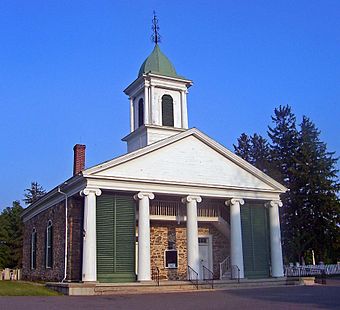Reformed Church of Shawangunk facts for kids
The Reformed Church of Shawangunk is a very old and important church located in the town of Shawangunk, New York. It sits on a hill with a great view of the Shawangunk Kill and the nearby Shawangunk Ridge. This church was built a long time ago, between 1752 and 1755. It is special because it's the oldest building still used by Dutch Reformed Church groups in America.
It is also listed on the National Register of Historic Places. This means it's a very important historical site. Some church leaders who started their careers here helped shape the larger Reformed Church in the U.S.
Quick facts for kids |
|
|
Reformed Church of Shawangunk
|
|

Main church building in 2007
|
|
| Location | Town of Shawangunk, NY |
|---|---|
| Nearest city | Newburgh |
| Area | 4 acres (1.6 ha) |
| Built | 1755. Greek Revival Portico added in 1833. |
| Architectural style | Greek Revival |
| NRHP reference No. | 82003408 |
| Added to NRHP | June 3, 1982 |
Contents
A Look Back: The Church's Story
How the Church Began
People in this area have had a church group since 1736. That year, five baptisms were recorded. Early settlers, including Dutch, German, and Huguenot families, used to travel to Kingston for their religious needs.
But as more people moved to the area, they wanted a church closer to home. So, in 1751, a man named Isaac Hasbrouck bought six acres of land. This land was for building a new church.
Building the Church
After the minister's house, called a parsonage, was built across the road, work began on the church itself. This was in 1752. People who gave money to build the church received special seating areas called pews.
Stories say that workers even built temporary fences to protect themselves while building. The nearby Bruynswick Rural Cemetery started having burials that same year. The church group officially formed in 1753. The Rev. Barent Vrooman was their first pastor.
Early Years and Changes
The church officially opened on December 26, 1755. The pews were sold, and the building was ready. Johannes Goetschius became the pastor in 1760. He served until he passed away in 1771. He was buried inside the church, under where the pulpit (the raised stand for the speaker) used to be.
The church building had its first big updates in the late 1790s. The inside of the church was changed around. The windows on the west side became the new doors. The pulpit was moved to the east wall. The pews were also turned to face the new pulpit. At this time, the parsonage also got a second floor.
Later Additions and Recognition
In 1833 and 1834, five large columns were added to the front of the church. These columns were in the popular Greek Revival style. They were added to protect the doors. The original entrance on the south side was finally closed off in 1881.
A third building, a church hall, was added to the west side of the church in 1916. This hall got a new section in 1958 for a modern kitchen and bathroom. Another section was added in 1990 for more space. In 1982, the church and its other buildings were listed on the National Register of Historic Places. This showed how important all the buildings and the cemetery were to history.
The Church's Important Role
New Churches and Leaders
The Shawangunk Reformed Church helped start five other local Dutch Reformed Church groups. These include churches in New Hurley, New Prospect, Guilford, Wallkill, and Gardiner. The New Hurley church is also on the National Register.
Two former pastors from this church became President of the Reformed Church in America. Ryniew Van Nest was president in the late 1700s. Charles Scott became president about a century later. Scott left Shawangunk to teach at Hope College in Holland, Michigan. He served as church president from 1881 to 1892. He is buried in the church's cemetery.
Other Important People
John Van Vleck was a former member of the church who became a minister. He helped start Holland Academy, which later became Hope College. Van Vleck Hall on the college campus is named after him.
Abraham Wilson was another former pastor. He left to lead the Reformed Church in Fairfield, Illinois, in 1837. This was the church's first group in what was then called the West.
Role in the American Revolution
At least 143 men from the church group fought in the American Revolutionary War. This was the war for America's independence. Of these brave men, 43 are buried in the church's cemetery.



